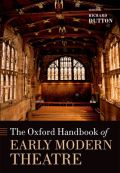
An international team of scholars examines the theatrical world in which Shakespeare worked, tracing the social, political, and patronage pressures under which actors operated. They also explore the practicalities of playing: acquiring scripts, theatres, rehearsing, lighting, music, props, boy actors, and therole of women in an 'all-male' world. There was no single 'Elizabethan stage'. Early modern actors exploited various opportunities for patronage and profitbetween the 1570s and 1642, whether touring, or performing at inns, in country houses, in purpose-built theatres, at court, at the universities, or at the inns of court. This authoritative and comprehensive collection of new essays explores the social, political, and economic pressures under which the playing companies of Shakespeare and his contemporaries operated.It shows how they evolved over time to meet new challenges such as the opposition of City of London authorities, the possibility of permanent location in London, the re-emergence of boy companies c. 1600, and the great increase in court performance which began under James I. Essays also explore thepractical everyday business of playing: acquiring scripts and playhouses, dramatic authorship, the contribution of financiers and entrepreneurs, rehearsing, lighting, music, props, styles of acting, boy actors, and the role of women in an 'all-male' world. A number of contributors address the methodologies of theatre history itself, questioning its philosophical premises and evaluating the nature of the evidence we have, such as that from stage directions in play-books or from the visualrecords. The collection as a whole offers a challenging account of the world of the players in Tudor-Stuart England, revising old assumptions and so inviting us to explore anew the plays which were written for them and which are their greatest living legacy. INDICE: Introduction: Early Modern Theatre History: where we are now, how we got here, where we go next Section A: Theatre Companies Adult Playing Companies to 1583 Adult Playing Companies, 1583 to 1593 Adult Playing Companies, 1593 to 1603 Adult Playing Companies 1603 to 1613 Adult Playing Companies 1613 to 1625 Adult playing companies 1625 to 1642 Early (pre-1590) Boy Companies & their Acting Venues The boy companies 1599-1613 Section B: London Playhouses Inn-yard Playhouses The Theatre in Shoreditch, 1576-1599 Why the Globe is Famous The Most Convenient Place: The Second Blackfriars Theatre and Its AppealThe Red Bull Playhouse The Phoenix and the Cockpit-in-Court Playhouses Section C: Other Playing Spaces 'He who pays the piper calls the tune': Household Entertainments The Universities and the Inns of Court Touring Court theatre London Street Theatre Section D: Social Practices Not Just Sir Oliver Owlet: FromPatrons to 'Patronage' of Early Modern Theatre The Court, The Master of theRevels and The Players Theatre Entrepreneurs and Theatrical Economics The City of London and the Theatre Players, Livery Companies, and Apprentices Materiality and the Market: the case of the Lady Elizabeth's Men. The Lady Elizabeth's Men and the challenge of theatre history 'For the author's credit': Issuesof Authorship in English Renaissance Drama Women in the Theatre Section E:Evidence of Theatrical Practices Early Modern Naturalistic Acting: The Role of the Globe in the Development of Personation Actors' Parts Stage Directionsand the Theatre Historian Lighting Music and sound Properties Eyewitnesses toHistory: Visual Evidence for Theatre in Early Modern England Christopher Beeston, His Property and Properties Composite Bibliography Index
- ISBN: 978-0-19-969786-1
- Editorial: Oxford University
- Encuadernacion: Rústica
- Páginas: 752
- Fecha Publicación: 13/10/2011
- Nº Volúmenes: 1
- Idioma: Inglés
